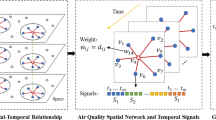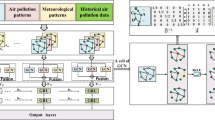Abstract
The most difficult problem in air pollution control is the accurate traceability of pollutants because atmospheric motion is affected by many factors. In this paper, based on the analysis of data, we propose an isolated forest-graph neural network-full connectivity algorithm, i.e., the IGF model to avoid the problem of capturing spatial information between data points due to the presence of unfixed relationships between data points in multi-source air pollution data, which cannot be represented through regular tensors or matrices. We utilize the IGF model to analyze the distribution characteristics of hourly air quality data and meteorological data in eight regions of Beijing between January 1, 2022, and May 31, 2022. First, the feature importance of each region is predicted, which is used to calculate the contribution of each region, and then, the pollution sources are divided into regional classes based on the regional contribution, and the spatial distributions of stations of different classes are combined to determine the final traceability results. The final traceability results are determined by combining the spatial distribution of sites of different levels. The experimental results show that the IGF model has higher prediction accuracy than the mainstream models to ensure the accuracy of traceability. Combining regional traffic flow, energy consumption, and geographical factors, we acquire the result that Chaoyang District has the highest level of pollution, with O\(_3\) as the main pollutant, and Changping and Huairou Districts have the lowest levels of pollution. This result can provide a scientific basis and technical support for the government to control air pollution in Beijing.











Similar content being viewed by others
References
Mi, X., Guangfu, W., Hongzhong, S., Yingjie, C., Ya, X., Chenlong, Z., Menglin, Q.: Characterization of pm2.5 mass concentration of Beijing in 2014. Chin. J. Environ. Eng. 10, 4396 (2016). https://doi.org/10.12030/j.cjee.201503200
Shuxiao, W., Yaosheng, C., Jiayu, X., Jiming, H.: Study on air quality impacts and control strategies of coal combustion in Beijing. Chin. J. Environ. Eng. 4, 151 (2010)
Fu-mo, Y., Ke-bin, H., Yong-liang, M., Qiang, Z., H, C.S., T, C., A, M.P.: Characterization of mass balance of pm2.5 chemical speciation in Beijing. Environ. Chem. 23, 326 (2004)
Jun, L., Rongxuan, Z., Banglei, Z., Yang, L., Zhitao, S., Chunlin, M.: Current situation, difficulties and solutions of urban village sewage treatment in the Beijing–Tianjin–Hebei region represented by Beijing. Chin. J. Environ. Eng. 16, 4162 (2022). https://doi.org/10.12030/j.cjee.202208089
Sharma, P.K., Atul Gautam, P.B.: Analysis of terrain of site mamatkheda ratlam through wind modeling tool arcgis and wasp. Mater. Today Proc. 46, 5661–5665 (2021). https://doi.org/10.1016/j.matpr.2020.09.638
Mazur, D.M., Polyakova, V.B.A.O.V.: Novel pollutants in the Moscow atmosphere in winter period: Gas chromatography-high resolution time-of-flight mass spectrometry study. Environ. Pollut. 222(242–250), 1 (2017). https://doi.org/10.1016/j.envpol.2016.12.049
Yogesh Agrawal, A.G., Bhagoria, J.L.: Investigation of thermal performance of a ribbed solar air heater for sustainable built environment. Sustain. Energy Technol. Assessm. 57, 103288 (2023). https://doi.org/10.1016/j.seta.2023.103288
Xine, Z., Zhonghua, W., Jun, L., Huawei, Z.: Research and application of integrated observation-source inventory coupling method in the source analysis of atmospheric particulate matter in Xiangyang. Front. Environ. Prot. 10(4), 13 (2020)
Shuxian, Z., Yang, L., Zhongzhi, Z., Xiaohui, D., Shuangxi, X., Fan, M.: Source apportionment of ozone in summer in beijing based on cmaq/isam air quality model. Res. Environ. Sci. 35(5), 1183–1192 (2022). https://doi.org/10.13198/j.issn.1001-6929.2021.10.11
Wong, Y.K., Huang, X.H.H., Cheng, Y.Y., Yu, J.Z.: Estimating primary vehicular emission contributions to pm2.5 using the chemical mass balance model: accounting for gas-particle partitioning of organic aerosols and oxidation degradation of hopanes. Environ. Pollut. 291, 118131 (2021). https://doi.org/10.1016/j.envpol.2021.118131
Jia-ying, Z., Jun-lin, A., Yue-zheng, F., Jie, H., Yu-xin, Z., Jun-xiu, W.: Atmospheric ozone concentration prediction in Nanjing based on Lightgbm. Environ. Sci. 44(7), 3685–3694 (2023)
Atul Gautam, J.L.B., Warudkar, V.: Comparison of weibull parameter estimation methods using lidar and mast wind data in an indian offshore site: The gulf of khambhat. Ocean Eng. 266, 112927 (2022). https://doi.org/10.1016/j.oceaneng.2022.112927
García Nieto, P.J., Sánchez Lasheras, F., García-Gonzalo, E., de Cos Juez, F.J.: Pm10 concentration forecasting in the metropolitan area of oviedo (northern spain) using models based on svm, mlp, varma and arima: a case study. Sci. Total Environ. 621, 753–761 (2018). https://doi.org/10.1016/j.scitotenv.2017.11.291
Chen, J., Zhao, F., Sun, Y., Yin, Y.: Improved xgboost model based on genetic algorithm. Int. J. Comput. Appl. Technol. 62, 240–245 (2020)
Haifeng, X., Xiaoli, H., Zheng, Z.: Air quality prediction based on adaptive boosting combinatorial model. Cybersecur. Data Govern. 41(12), 84–89 (2022)
Shikai, M., Hongzhao, D., Qiang, Y., Yang, X., Yingying, L.: Research on accurate traceability of air pollution in aqp region oriented to multi-source data. J. Environ. Sci. 43(04), 131–141 (2023)
Xiaoming, Z., Kemin, G., Shiqing, Z.: Research progress in deep learning oriented air quality prediction. Comput. Syst. Appl. 31(11), 131–141 (2022)
Baowei, W., Weiwen, K., Hui, G., Xiong, N.N.: Air quality forecasting based on gated recurrent long short term memory model in internet of things. IEEE Access 7, 69524–69534 (2019). https://doi.org/10.1109/ACCESS.2019.2917277
Yuanyuan, L., Yufei, C.: An air quality visualisation platform integrating cnn-lstm prediction models. Inf. Technol. Inform. 265(04), 19–22 (2022)
Zamani Joharestani, M., Cao, C., Ni, X., Bashir, B., Talebiesfandarani, S.: Pm2.5 prediction based on random forest, xgboost, and deep learning using multisource remote sensing data. Atmosphere (2019). https://doi.org/10.3390/atmos10070373
Yang, G., Lee, H., Lee, G.: A hybrid deep learning model to forecast particulate matter concentration levels in Seoul, South Korea. Atmosphere (2020). https://doi.org/10.3390/atmos11040348
Cao, D., Wang, Y., Duan, J., Zhang, C., Zhu, X., Huang, C., Tong, Y., Xu, B., Bai, J., Tong, J., Zhang, Q.: Spectral Temporal Graph Neural Network for Multivariate Time-series Forecasting. 2103–07719 (2021) https://doi.org/10.48550/arXiv.2103.07719arXiv:2103.07719 [cs.LG]
Yingkui, D., Yifang, Z., Zhonghu, Y., Ping, G., Yue, P.: Analysis of data preprocessing on the accuracy of air pollution prediction by lstm networks. Comput. Digital Eng. 49(7), 6 (2021)
Cen, C.H.E.N., Xiaodan, W.W.T.I.A.N.: Application of ig-lstm model in air quality index prediction. J. North China Acad. Sci. Technol. 17(04), 85–91 (2022)
Funding
This work was supported by the projects of National Natural Science Foundation of China (No. 51776116) and China University-Industry-Research Innovation Fund for Next-Generation Information Technology Innovation Projects (2021ITA03008).
Author information
Authors and Affiliations
Corresponding author
Ethics declarations
Conflict of interest
The authors have no conflicts of interest as defined by Springer, or other interests that could be perceived as influencing the results and/or discussion reported in this paper.
Additional information
Publisher's Note
Springer Nature remains neutral with regard to jurisdictional claims in published maps and institutional affiliations.
Rights and permissions
Springer Nature or its licensor (e.g. a society or other partner) holds exclusive rights to this article under a publishing agreement with the author(s) or other rightsholder(s); author self-archiving of the accepted manuscript version of this article is solely governed by the terms of such publishing agreement and applicable law.
About this article
Cite this article
Fang, H., Liang, J. & Wang, J. Implementation of air pollution traceability method based on IF-GNN-FC model with multiple-source data. Int J Data Sci Anal (2023). https://doi.org/10.1007/s41060-023-00482-w
Received:
Accepted:
Published:
DOI: https://doi.org/10.1007/s41060-023-00482-w




